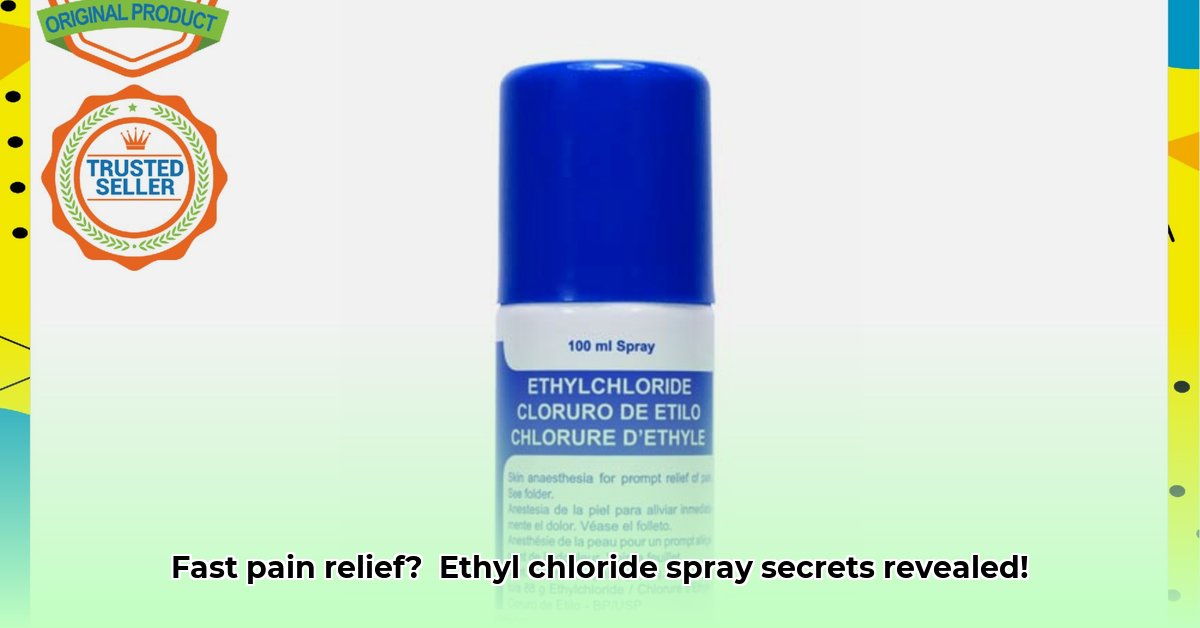Are you experiencing sudden pain? Ethyl chloride spray provides quick relief, but understanding its safe application is crucial. This comprehensive guide details its mechanism, proper usage, and safety precautions to prevent frostbite and other complications. We’ll explore diverse perspectives and user tips, emphasizing responsible and safe application due to its flammability. For additional natural remedies, check out this article on castor oil benefits.
Understanding Ethyl Chloride Spray for Rapid Pain Relief
Ethyl chloride spray delivers rapid pain relief by inducing a super-cooling sensation, effectively numbing the targeted area and temporarily alleviating discomfort. This immediate “freeze” offers nearly instantaneous relief, with the duration contingent upon the amount applied and the specific application site. What are the critical factors in ensuring maximum safety when utilizing this spray?
Common Uses for Ethyl Chloride Spray
Ethyl chloride spray is frequently used for brief, rapid procedures such as numbing the skin prior to injections, managing minor cuts and scrapes, and providing relief from muscle and joint pain following workouts or injuries. It delivers a swift burst of temporary numbing action. How does this compare to other available pain management strategies?
Safe Application Techniques for Ethyl Chloride Spray
Safety must be the highest priority when using ethyl chloride spray. Always thoroughly review the product instructions before use!
-
Maintain an Upright Position: Ensure the can is held upright during application to facilitate even spraying. Tilting the can can lead to an uneven spray pattern, resulting in inconsistent coverage and potential concentrated cold spots.
-
Apply Short Bursts: Administer the spray in brief, controlled bursts, typically lasting one to three seconds, to minimize risks. Prolonged spraying can induce frostbite, causing cold-related injury to the skin.
-
Use a Sweeping Motion: Avoid prolonged spraying in a single location to ensure uniform coverage. Instead, move the can swiftly back and forth across the intended target area.
-
Allow for Air Drying: Permit the sprayed area to air dry naturally without interference. Refrain from rubbing or immediately covering the area to prevent potential irritation and optimize the cooling effect.
Essential Safety Guidelines for Using Ethyl Chloride Spray
Ethyl chloride spray is highly flammable, requiring strict adherence to safety protocols, including maintaining a safe distance from open flames, sparks, or any potential ignition sources. Avoid inhaling the spray to protect respiratory health, and prevent eye contact to avoid stinging or irritation. Overuse, even if infrequent, carries the risk of frostbite, underscoring the need for responsible application. Always keep the spray out of reach of children to prevent accidental misuse.
Potential Side Effects and Associated Risks
While generally safe when used as directed, ethyl chloride spray may cause side effects such as skin irritation, allergic reactions (manifesting as rashes), and frostbite resulting from overuse. Although rare, more severe reactions have been reported, emphasizing the paramount importance of safety. If any concerns arise, carefully review the product label and consult a physician or pharmacist for guidance.
Steps to Take in Case of Adverse Reactions
Seek immediate medical attention for severe skin irritation or allergic reactions. If the spray is accidentally inhaled, move to an area with fresh air and contact a doctor or urgent care facility. Remember, safety should always be the primary concern in such situations.
Long-Term Effects of Ethyl Chloride Spray: Current Understanding
The long-term effects of ethyl chloride spray are not yet fully understood. Preliminary studies suggest potential concerns associated with prolonged or frequent use, but additional comprehensive research is needed. Exercise caution and meticulously adhere to the product instructions. Discuss any concerns regarding long-term usage with a healthcare provider. Should the potential for long-term effects be a factor when deciding whether to use ethyl chloride spray?
Finding Trustworthy Information About Ethyl Chloride Spray
For accurate and reliable information, consult healthcare professionals, such as doctors and pharmacists, or refer to official government health websites. Be cautious when evaluating online sources, as not all information may be reliable or accurate.
Key Points About Ethyl Chloride Spray
Ethyl chloride spray provides rapid pain relief for minor aches and discomfort. However, safety must be the highest priority. Always follow the instructions carefully and consult a healthcare professional if you have any uncertainties. Don’t hesitate to ask questions to ensure peace of mind and proper usage.
Applying Ethyl Chloride Spray Safely for Minor Procedures
Key Takeaways:
- Ethyl chloride delivers rapid, temporary numbing.
- It is effective for specific minor procedures and injuries.
- Flammability and the potential for misuse are significant concerns.
- Safe handling and application techniques are crucial.
- Healthcare professionals must adhere to strict protocols.
Understanding Ethyl Chloride’s Properties
Ethyl chloride functions as a fast-acting topical anesthetic, inducing insensitivity to pain in the targeted area. It works by rapidly cooling the skin, which numbs the pain receptors for short procedures. Like any medical tool, it requires careful and precise handling. How does its speed and effectiveness compare to other anesthetics?
How Does Ethyl Chloride Provide Pain Relief?
The evaporation process is fundamental to its mechanism. Upon application, ethyl chloride transitions from a liquid to a gaseous state, drawing heat away from the skin. This rapid cooling action provides efficient and temporary pain relief.
Detailed Instructions for Safe Application of Ethyl Chloride Spray in Minor Procedures:
Safety must be paramount, and involves meticulous adherence to these instructions:
-
Prioritize Preparation: Ensure adequate ventilation in the treatment area to prevent the accumulation of flammable vapors. Eliminate any open flames or potential sources of electrical sparks.
-
Clean the Target Area: Thoroughly cleanse the treatment area with an antiseptic solution to minimize the risk of infection.
-
Administer Short Bursts: Apply the spray in controlled, short bursts, maintaining a distance of 6-12 inches from the skin. The precision of the application directly influences its effectiveness.
-
Avoid Prolonged Contact: Refrain from spraying for extended periods to prevent frostbite, which can cause damage to the skin tissue.
-
Monitor the Application Area: Closely monitor the treated area for any indications of frostbite, such as the appearance of white or pale skin. Early detection is crucial for preventing serious complications.
-
Dispose of Properly: Adhere to local hazardous waste disposal regulations to prevent environmental contamination.
Potential Risks and Essential Precautions
While generally considered safe when used correctly, ethyl chloride poses flammability risks, necessitating its use in well-ventilated environments. Inhaling the spray can be hazardous, and over-application can lead to frostbite and skin irritation. Given these risks, is ethyl chloride always the most appropriate choice?
Appropriate Candidates for Ethyl Chloride Use
The use of ethyl chloride should be limited to licensed healthcare professionals who have received comprehensive training in its safe and effective application. Using ethyl chloride outside of a medically supervised setting is strongly discouraged due to inherent risks and the potential for misuse.
Exploring Alternatives to Ethyl Chloride
Alternative pain management techniques exist, depending on the specific procedure being performed. A local anesthetic injection may be preferable for more extensive procedures. Consult with a healthcare professional to discuss the available options and determine the most suitable choice. How do the potential side effects of alternative methods compare to those associated with ethyl chloride?
Ethyl Chloride Spray: Applications in Minor Surgical Procedures
Key Takeaways:
- Ethyl chloride spray provides rapid, temporary numbing.
- It’s effective for minor procedures and injuries.
- Proper technique minimizes risks like frostbite.
- Flammability necessitates careful handling.
- Long-term effects require further research.
Mechanism of Action of Ethyl Chloride Spray
Ethyl chloride functions as a vapocoolant anesthetic. When applied to the skin, it rapidly evaporates, creating a cooling effect that numbs the targeted area. This enables relatively painless completion of procedures, typically within a minute or less. What is the correlation between accurate application and the duration of the anesthetic effect?
Applications of Ethyl Chloride Spray in Minor Surgical Procedures
The applications of ethyl chloride spray in minor surgical procedures are diverse. Doctors utilize it for:
-
Injections: Reducing discomfort associated with needle pricks, facilitating easier administration and reducing patient anxiety.
-
Wound Cleaning: Numbing sensitive areas prior to cleaning or suturing minor cuts, enabling thorough cleansing.
-
Minor Dermatological Procedures: Assisting with mole removal or other small skin procedures, enhancing patient comfort during delicate interventions.
-
Orthopedic Procedures: Alleviating pain during the treatment of minor joint injuries, allowing for better examination and manipulation of affected joints.
-
Sports Medicine: Providing temporary pain relief for sprains, strains, and minor dislocations, enabling athletes to receive prompt care on the field.
It is crucial to emphasize that ethyl chloride spray is not a replacement for proper anesthesia in major surgeries; its utility is limited to small, short procedures.
Essential Safety Precautions for Handling Ethyl Chloride Spray with Care
Ethyl chloride is highly flammable, necessitating strict adherence to safety protocols. It must be kept away from open flames and electrical cautery devices. Always follow the manufacturer’s instructions precisely to minimize risks.
Frostbite is a potential complication if ethyl chloride is used incorrectly. Avoid prolonged spraying in one area, and instead, apply light, brief sprays. Monitor the treated area for any signs of skin damage following use. Allergic reactions, while infrequent, are possible; therefore, performing a quick skin test beforehand is a prudent precaution.
Although current research suggests a low risk at standard clinical dosages, the long-term effects of ethyl chloride spray are not fully understood, warranting further research.
Step-by-Step Guide to Proper Application Technique
- Preparation: Ensure that the treatment area is clean and dry. Wear protective gloves for hygiene. Position the patient in a comfortable position. Verify
- Where to Buy Bento Boxes for Healthy, Organized Meals - December 9, 2025
- Plastic Bento Boxes Make Meal Prep and Cleanup Effortless - December 8, 2025
- Shop Bento Lunch Boxes on Sale Nearby Now - December 7, 2025










